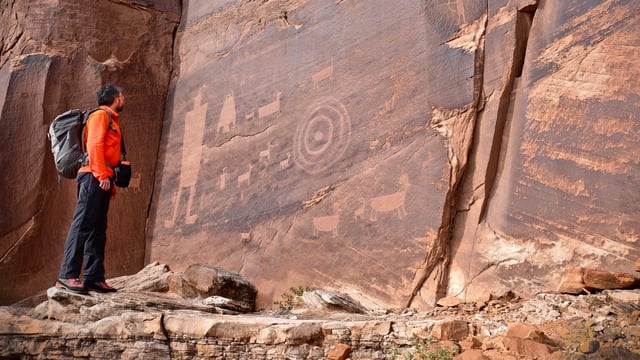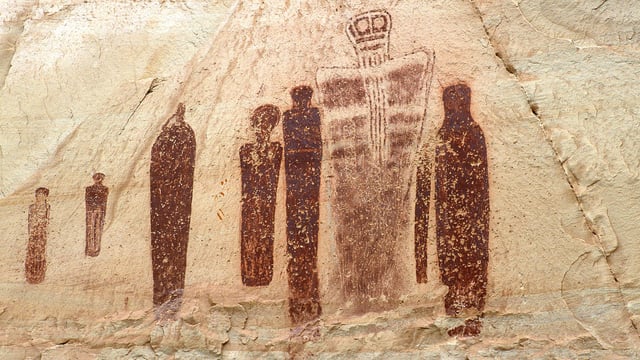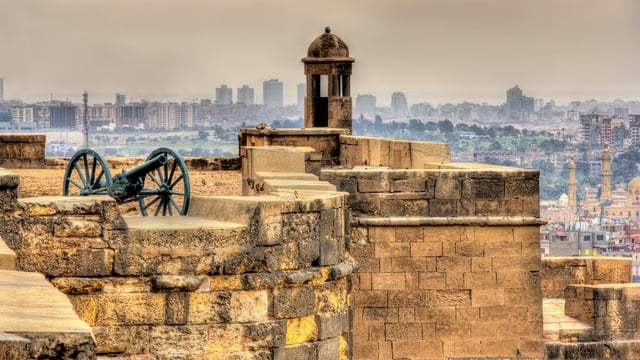In the heart of red rock landscapes and canyonlands of south east Utah is the small resort town of Moab. One of the reasons many come to spend a few days here is to explore the archaeology and rock art. Not only are there a number of both petroglyph and pictograph sites in the area, these sites have images from a number of different periods of history from 5500 BC to the 1800s. This guide provides information for those who are looking to see just a few of the better sites as well as those would like to see as much as they can. The interactive map and directions can be used for self-guided rock art tours. Also included are details of rock art auto tours from Moab.
- Thomas Dowson
- Last Checked and/or Updated 15 December 2021
- No Comments
- USA
You really do not have to go too far to see rock art while staying in Moab. There are a number of very good sites within a 25 km radius of the town. Whether you want to see one or two exceptional sites, or you would like to see as many as you can. Whether you are looking for sites with easy access, or are looking to see a few sites as part of a moderate hike. Moab has a collection of sites to suit all levels of interests.
And of the sites and rock art themselves. There are both petroglyphs and pictographs, engravings and paintings. Art that is relatively old, and art that is relatively recent. Of the different traditions, you will find Barrier Canyon style rock art, Freemont, Basketmaker and Ancestral Puebloan rock arts.
When visiting rock art sites, this applies to all archaeological and historical sites, remember that despite their age they are sensitive sites. Read the widely accepted guidelines for visiting rock art and archaeological sites.
While there are some rock art sites that are signposted, the vast majority are not (many of which are not even on public maps). This is simply to not advertise these sites for people who are likely to vandalise them. To find rock art sites near Moab, search out Interactive Map of Rock Art Sites. We only locate sites that are relatively well known. This does not mean the usual visitor etiquette for visiting rock art sites should not be observed at all sites, and at all times.
Ettiquette for Visiting Rock Art Sites
When visiting rock art sites, whether in Moab or elsewhere, be mindful of the impact your visit makes. Not only do these sites suffer as a result of natural weathering processes, unfortunately the actions of visitors is not always ideal. Of course in some cases visitors are not fully aware of how destructive their actions can be.
Most people would not dream of adding graffiti to these panels, or recording the date of their visit. Without even thinking about it, and quite understandably, many do not know that you should not touch a painted or engraved image. After all these images have been exposed to the harsh elements for centuries. But that print your fingers leave on glass contains acids that can destroy not only pigments by the eroding rock surface. So the do not touch rule applies as much to engravings as it does to paintings.
Before setting off on your journey be mindful of and pay attention to local restrictions. And read the widely accepted etiquette for visiting rock art, and other archaeology, sites in our Rock Art Guide.
Rock Art Sites In And Around Moab
Great Gallery, Horseshoe Canyon
Horseshoe Canyon has one of the finest and most well known rock art sites in North America. On a rock shelter wall at the bend in the canyon creek is the largest panel of the Barrier Canyon style pictographs. Here there is a panel that is over 60 metres long and about 4.6 metres high – commonly referred to as Horseshoe Canyon’s Great Gallery. Painted on the rock shelter wall are about 20 life-sized human-like images, the largest being over 2 m in height. On the far left of the Great Gallery are a handful of strikingly shapeless figures. As they seem to ‘hover’ on the rock face, these figures are said to have a ghostly appearance, and are sometimes called the ‘holy ghosts’.


3-Hour Off-Road Rock Art Tour
Scrambling around the rocky sides of valleys looking for rock art is not for everyone. Particularly if it is hot. If you want to get to see a few petroglyph sites but would rather not do this yourself, then take a guided tour. And if you want to combine a bit of history with exploring the back roads in a 4×4, then this really is the perfect guided tour for you. On this Three-Hour Offroad Rock Art Auto Tour not only will you get to see petroglyphs, but you will also see breath taking views of towering canyon walls along the Colorado River in a 4×4 vehicle.









